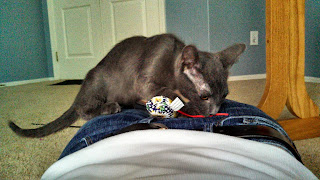Sometimes when kittens have been living outdoors for as little as 7-8 weeks with no human contact, the part of them that is feral takes a very long time to domesticate. In some cases they are never fully domesticated and remain what is called semi-feral.
Feral means that the cat is not friendly with people, but often bonds and enjoys the company of other cats.
Semi-feral is when the cat will allow people to come close and receive affection. The cat may sit in your lap. But sudden movements or trying to pick up the cat will send kitty running off to hide, generally with evident signs of displeasure.
Wrenly had been in another home for a short while. She had been found later than her siblings and was not domesticating as they were. To separate her from her siblings and other cats, she came to me to try a different method of domestication.
By no means am I an expert at working with this type of kitten, but I've had some good outcomes in the past and have some tricks that have been effective.
 |
| First day at my home, frightened, hiding and hissing. |
 |
| Beechnut Chicken baby food on my hand. |
 |
| Socializing is exhausting. |
Being around me for too long is quite exhausting for her in the first few days. I leave her be to rest, but it is clear she is becoming comfortable in her bathroom environment.
 | |
| Bigger room with a window and tall cat tree. |
It was time for Wrenly to be able to run, climb and have a window. I removed her hiding space and put in a cat crate. She was eager for cover, ran to the crate and it was easy to transport her to a real room. At this stage, she is being kept separate from all other cats, except the toy kind. The hope is she will become so lonely and desperate for affection that she will let people pet her and get close to her.
 | ||
| Will touch me and climb on me, but No petting, yet. |
 |
| Playing on the floor. Laying flat is the least intimidating position. |
Staying low to the floor is the least intimidating position when working with a feral or scared cat.
While on the floor my husband was able to touch Wrenly. Some cats have a preference for men or women. At this point she seems to prefer my husband.
 | |
| Off the floor, on a chair, touching me and playing with the camera. |
As the days pass, Wrenly identifies me as the person that brings the food, gives her fresh water and plays with her. I spend anywhere from 30-60 minutes at a time with her, sometimes playing with her, sometimes ignoring her, reading a book, writing or working on my lap top. After 3 weeks she has decided she wants to be on the chair with me. And she really likes the camera strap. On and off my lap, up around my head and then....
 | ||
| Maybe petting isn't so bad after all |
Each day she is a little more confident, and with each day her Russian Blue traits are revealing themselves. See her ears that are too big. That's one of the physical traits. Her paw pads are also a soft almost purple color. (I'll try to get a picture). Russian Blues like to be pet. They like to sit close by. They Love to play, especially the game of fetch. They are very smart. They are social with the people they trust, but are typically shy of strangers.
 |
| Russian Blue Wrenly |
 |
| Bird watching with her friend. |
 |
| Books, paper and pens are an instant invitation to sit in my lap. |
I'll keep you posted for the day I can pick her up more than 2 inches from the ground. She may never see the inside of a Petsmart Adoption Center, but I do hope to find her a home that will be patient with her. She is affectionate, playful, smart and has the characteristics of a Russian Blue.
Wrenly is up-to-date on vaccinations, she is spayed, and she is micro chipped by Friends-for-Life-Animal-Rescue.
No comments:
Post a Comment